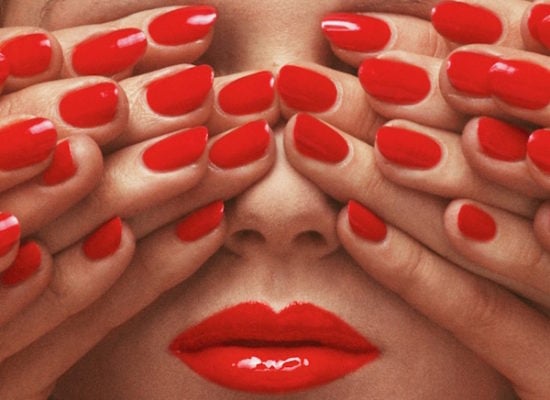For more than three decades, Guy Bourdin’s vibrant, enigmatic, and sexy photographs graced the covers of the most glamorous glossy magazines, shaping the history of fashion photography along the way. Now, London’s Somerset House is hosting the largest exhibition of works by this maverick French photographer since his death in 1991.
“Guy Bourdin: Image-Maker” features over 100 works (some of them only recently released into the public realm), which trace the span of Bourdin’s career: from Man Ray’s protégé to one of the most iconic fashion photographers of the 20th century.
The exhibition also includes a generous assortment of unseen material from the photographer’s estate, which offers an in-depth insight into Bourdin’s meticulous artistic methodology. These include black and white photographs, Polaroid tests, contact sheets, paintings, sketches and even rare Super-8 films, shot while on location.
Since debuting professionally for Vogue Paris in the 1950s—with a photograph of a sophisticated hat-clad model in a butcher’s shop, framed by three severed cow heads with their tongues sticking out—Bourdin steadily developed a unique style of visual storytelling, which both anticipated and influenced the work of many contemporary fashion photographers.
Despite working in the realm of commercial photography, Bourdin took an uncompromisingly creative approach to his fashion spreads and ad campaigns, controlling every single aspect of the process, down to the hair and make up of the models. He would only submit one negative for each image, and would indicate its precise placement on the page. His eccentricities with his publishers and editors didn’t end there: rumor has it that he used to choose models based on their star signs, and that he once arrived to the Vogue Paris offices riding a camel.
According to the Guardian, his colorful (some even say turbulent) personal life was a fit match for his daring art. He was abandoned by his mother and had a difficult relationship with his father. Both Bourdin’s first wife and a subsequent girlfriend had premature deaths, and he often had problems with taxes, which plagued his estate with debts.
To say that Bourdin was uncompromising might be a bit of an understatement. He never published a book in his lifetime, never staged an exhibition of his color photography, and even rejected the Grand Prix National de la Photographie awarded by the French government. According to art history lore, the influential art curator and patron Sam Wagstaff, who launched Robert Mapplethorpe’s career, sent an open cheque to Bourdin and asked him to fill out the amount, but it came back to him torn into pieces.
While he might have been a difficult person to work with, there is no doubt that Bourdin left behind a remarkable body of visual work that doesn’t leave anyone indifferent. Often depicting disembodied body limbs from almost vanishing models—a leg sticking out here, a mannequin torso poking out there—Bourdin’s images are as sinister as erotically mesmerizing. They sometimes make for uncomfortable viewing, like a guilty pleasure in which perversion and beauty fold neatly into each other.
“Guy Bourdin: Image Maker” is on view at Somerset House, London, until March 15, 2015
